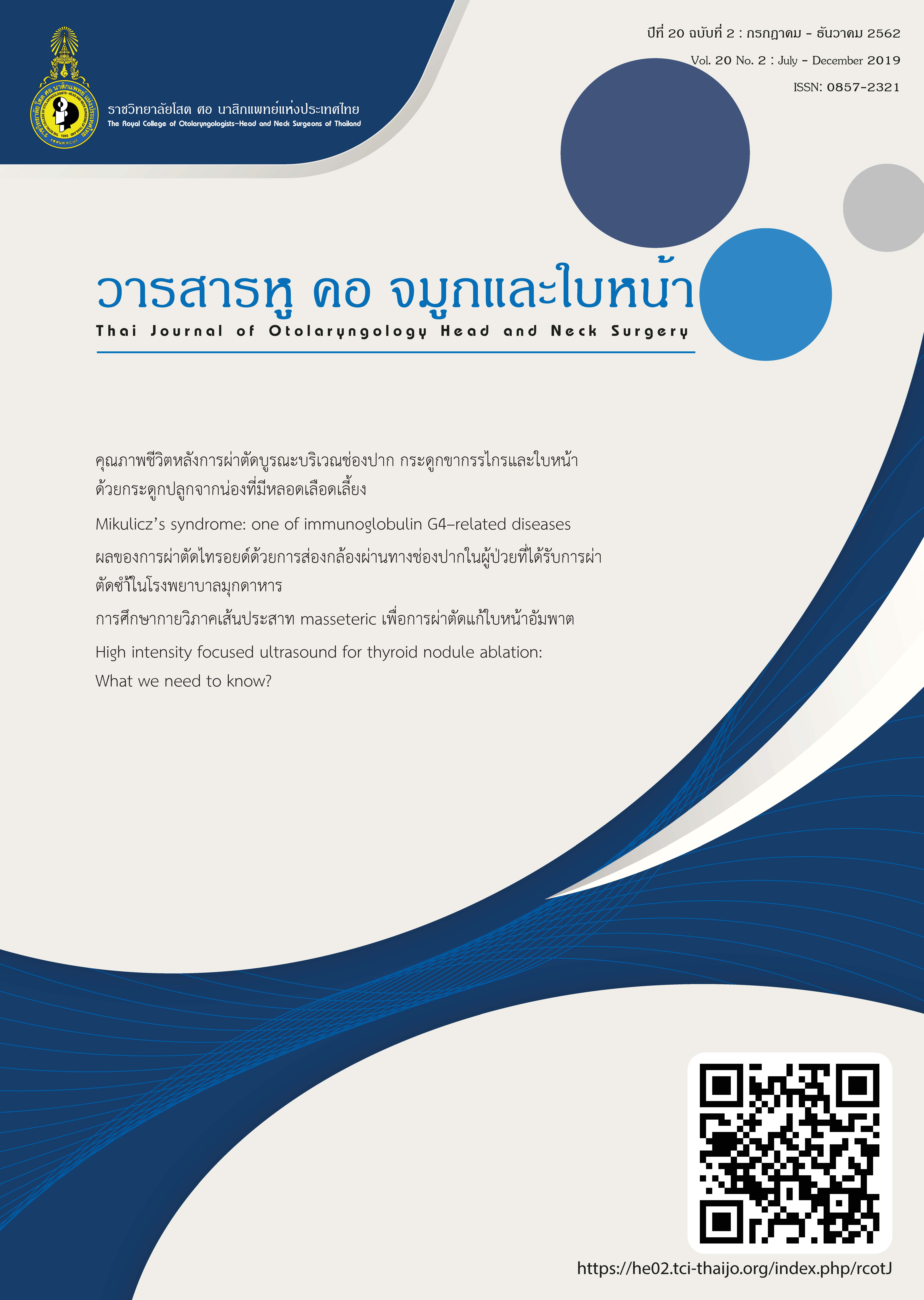Topographic anatomy of masseteric nerve for facial reanimation surgery
Main Article Content
Abstract
Abstract
Objective
Facial paralysis affects thousands of people every year. Nowadays Research into a better understanding of how to utilize the masseteric branch of V3 for facial reanimation surgery is growing both in the laboratory and clinically. masseteric–facial nerve neurorrhaphy also give better result compare with other procedures. Due to some different in structural anatomy of between Caucasian and Asian, the aim of this study is to describe the topographic anatomy of the nerve to masseter
for a quick and safe harvesting in Thai population.
Method
This anatomical study is based on the dissection of the nerve to masseter in 19 embalmed cadavers (38 sites) and is focused on the anatomical relations between the nerve and the surrounding structures. All of the nerves were recorded the position in relation with tragus, depth from SMAS layer, length and diameter
Result
From all 19 embalmed cadavers; 52.6% (10 cadavers) were male. A convenient starting point for its dissection was found 35.26 +/- 3.96 mm. anterior to the tragus at a level inferior to the zygomatic arch. The nerve was located 12.07 +/- 2.10 mm. deep to the superficial muscular aponeurotic system (SMAS) at this point. There were 2.63 percent of the nerves (1 site) that had 3 branches, 36.84 percent (14 sites) that had 2 branches and 60.53 percent (23 sites) that had only 1 branch. Average diameter of the nerves were about 1.76 +/- 0.43 mm
Conclusion
Nowadays many literature show a wide and growing range of surgical options that allows some degree of reanimation in facial paralysis. Research into a better understanding of how to utilize the masseteric branch of V3 for facial reanimation surgery is growing both in the laboratory and clinically. A consistent and convenient starting point for dissection of this nerve in Thai population from this study is found 3-3.5 cm anterior to the tragus at the level inferior to the zygomatic arch and about 1 cm depth to SMAS layer
Article Details
ต้นฉบับที่ส่งมาพิจารณายังวารสารหู คอ จมูก และใบหน้า จะต้องไม่อยู่ในการพิจารณาของวารสารอื่น ในขณะเดียวกันต้นฉบับที่จะส่งมาจะผ่านการอ่านโดยผู้ทรงคุณวุฒิ หากมีการวิจารณ์หรือแก้ไขจะส่งกลับไปให้ผู้เขียนตรวจสอบแก้ไขอีกครั้ง ต้นฉบับที่ผ่านการพิจารณาให้ลงตีพิมพ์ถือเป็นสมบัติของวารสารหู คอ จมูกและใบหน้า ไม่อาจนำไปลงตีพิมพ์ที่อื่นโดยไม่ได้รับอนุญาต
ตารางแผนภูมิ รูปภาพ หรือข้อความเกิน 100 คำที่คัดลอกมาจากบทความของผู้อื่น จะต้องมีใบยินยอมจากผู้เขียนหรือผู้ทรงลิขสิทธิ์นั้นๆ และใหร้ะบุกำกับไว้ในเนื้อเรื่องด้วย
References
2. Wachtman GS, Cohn JF, VanSwearingen JM,Manders EK. Automatedtracking of facial features in patients with facial neuromuscular dysfunction. Plast Reconstr Surg 2001; 107:1124-1133.
3. Popat H, Henley E, Richmond S, et al.A comparison of the reproducibility of verbal and nonverbal facial gestures using three-dimensional motion analysis. Otolaryngol Head Neck Surg 2010; 142:867-872.
4. Henstrom DK. Masseteric nerve use in facial reanimation. Curr Opin Otolaryngol Head Neck Surg. 2014 Aug;22(4):284-90.
5. Bianchi B, Ferri A, Sesenna E. Facial reanimation after nerve sacrifice in the treatment of head and neck cancer. CurrOpin Otolaryngol Head Neck Surg 2012;20:114-119.
6. Borschel GH, Kawamura DH, Kasukurthi R,et al. The motor nerve to the masseter muscle: an anatomic and histomorphometric study to facilitate its use in facial reanimation.J Plast Reconstr Anesth Surg 2012; 65:363-366.
7. Brenner E, Schoeller T. Masseteric nerve:a possible donor for facial nerve anastomosis? Clin Anat 1998; 11:396-400.
8. Collar RM, Byrne PJ, Boahene KD. The subzygomatic triangle: rapid, minimally invasive identification of the masseteric nerve for facial reanimation. Plast Reconstr Surg 2013;132:183-188.
9. Korte W. Nerve grafting: facial nerve on hypoglossal. Dtsch Med Wochenschr 1903;17:293-295.
10. Bianchi B, Ferri A, Ferrari S, et al. Cross-facial nerve graft and masseteric nerve cooptation for one-stage facial reanimation: principles,indications, and surgical procedure. Head Neck 2014; 36:235-240.
11. Gousheh J, Arasteh E. Treatment of facial paralysis: dynamic reanimation of spontaneous facial expression-apropos of 655 patients. Plast Reconstr Surg 2011; 128:693e-703e.
12. Sanghoon Park, Jihyuck Lee. Zygoma Reduction. In: Aesthetic Plastic Surgery of the East Asian Face. New York: Thieme Publishers New York; 2016. p. 243-253.


